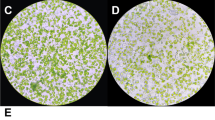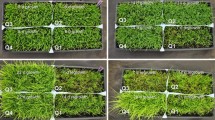Abstract
Pennycress (Thlaspi arvense) and camelina (Camelina sativa) are nonfood winter oilseed crops that have the potential to contribute to sustainable biofuel production. However, undesired agronomic traits of pennycress and camelina currently hinder broad cultivation of these plants in the field. Recently, genome editing using the CRISPR-Cas technology has been applied to improve poor agronomic traits such as the weedy phenotype of pennycress and the oxidation susceptible lipid profile of camelina. In these works, the CRISPR reagents were introduced into the plants using the Agrobacterium-mediated floral dipping method. For accelerated domestication and value improvements of these winter oilseed crops, DNA-free genome editing platform and easy evaluation method of the CRISPR-Cas reagents are highly desirable. Cell wall-free protoplasts are great material to expand the use of gene engineering tools. In this chapter, we present a step-by-step guide to the mesophyll protoplast isolation from in vitro culture-grown pennycress and soil-grown camelina. The protocol also includes procedures for DNA transfection and protoplast viability test using fluorescein diacetate. With this protocol, we can isolate an average of 6 × 106 cells from pennycress and 3 × 106 cells from camelina per gram of fresh leaf tissues. Using a 7.3 kb plasmid DNA carrying green and red fluorescent protein marker genes, we can achieve an average transfection rate of 40% validated by flow cytometry for both plants.
Access this chapter
Tax calculation will be finalised at checkout
Purchases are for personal use only
Similar content being viewed by others
References
Sindelar AJ, Schmer MR, Gesch RW, Forcella F, Eberle CA, Thom MD, Archer DW (2017) Winter oilseed production for biofuel in the US corn belt: opportunities and limitations. GCB Bioenergy 9:508–524
Isbell TA (2009) US effort in the development of new crops (Lesquerella, Pennycress Coriander and Cuphea). OCL Ol Corps Gras Li 16:205–210. https://doi.org/10.1051/ocl.2009.0269
Fröhlich A, Rice B (2005) Evaluation of Camelina sativa oil as a feedstock for biodiesel production. Ind Crops Prod 21:25–31
Soriano NU, Narani A (2012) Evaluation of biodiesel derived from Camelina sativa oil. J Am Oil Chem Soc 89:917–923
Dose HL, Eberle CA, Forcella F, Gesch RW (2017) Early planting dates maximize winter annual field pennycress (Thlaspi arvense L.) yield and oil content. Ind Crop Prod 97:477–483
Gesch RW, Archer DW, Berti MT (2014) Dual cropping winter camelina with soybean in the Northern corn belt. Agron J 106:1735–1745
Mitich LW (1996) Field pennycress (Thlaspi arvense L.)—The stinkweed. Weed Technol 10:675–678
Vaughn SF, Isbell TA, Weisleder D, Berhow MA (2005) Biofumigant compounds released by field pennycress (Thlaspi arvense) seedmeal. J Chem Ecol 31:167–177
Selling GW, Hojilla-Evangelista MP, Evangelista RL, Isbell TA, Price N, Doll KM (2013) Extraction of proteins from pennycress seeds and press cake. Ind Crop Prod 41:113–119
Moser BR, Knothe G, Vaughn SF, Isbell TA (2009) Production and evaluation of biodiesel from field Pennycress (Thlaspi arvense L.) Oil. Energy Fuel 23:4149–4155
EFSA Panel on Contaminants in the Food Chain (CONTAM), Knutsen HK, Alexander J, Barregård L, Bignami M, Brüschweiler B, Sandra C, Dinovi M, Edler L, Grasl-Kraupp B, Hogstrand C, Hoogenboom L, Nebbia CS, Oswald I, Petersen A, Rose M, Roudot AC, Schwerdtle T, Vollmer G, Wallace H, Cottrill B, Dogliotti E, Laakso J, Metzler M, Velasco L, Ruiz JA, Varga E, Dörr B, Sousa R, Vleminckx C (2016) Erucic acid in feed and food. EFSA J 14:e04593
Fan J, Shonnard DR, Kalnes TN, Johnsen P, Rao S (2013) A life cycle assessment of pennycress (Thlaspi arvense L.) -derived jet fuel and diesel. Biomass Bioenergy 55:87–100
Johnson GA, Kantar MB, Betts KJ, Wyse DL (2015) Field pennycress production and weed control in a double crop system with soybean in Minnesota. Agron J 107:532–540
Cubins JA, Wells MS, Frels K, Ott MA, Forcella F, Johnson GA, Walia MK, Becker RL, Gesch RW (2019) Management of pennycress as a winter annual cash cover crop. A review. Agron Sustain Dev 39:46. https://doi.org/10.1007/s1359301905920
Moore SA, Wells MS, Gesch RW, Becker RL, Rosen CJ, Wilson ML (2020) Pennycress as a cash cover-crop: improving the sustainability of sweet corn production systems. Agronomy 10:614
Altendorf K, Isbell T, Wyse DL, Anderson JA (2019) Significant variation for seed oil content, fatty acid profile, and seed weight in natural populations of field pennycress (Thlaspi arvense L.). Ind Crop Prod 129:261–268
Chopra R, Johnson EB, Emenecker R, Cahoon EB, Lyons J, Kliebenstein DJ, Daniels E, Dorn KM, Esfahanian M, Folstad N, Frels K, McGinn M, Ott M, Gallaher C, Altendorf K, Berroyer A, Ismail B, Anderson JA, Wyse DL, Ulmasoy T, Sdbrook JC, Mark MD (2020) Identification and stacking of crucial traits required for the domestication of pennycress. Nat Food 1:84–91
McGinn M, Phippen WB, Chopra R, Bansal S, Jarvis BA, Phippen ME, Dorn KM, Esfahanian M, Nazarenus TJ, Cahoon EB, Durrett TP, Mark MD, Sedbrook JC (2019) Molecular tools enabling pennycress (Thlaspi arvense) as a model plant and oilseed cash cover crop. Plant Biotechnol J 17:776–788
Zubr J (1997) Oil-seed crop: Camelina sativa. Ind Crop Prod 6:113–119
Francis A, Warwick SI (2009) The biology of Canadian weeds. 142. Camelina alyssum (Mill.) Thell.; C. microcarpa Andrz. ex DC.; C. sativa (L.) Crantz. Can J Plant Sci 89:791–810
Gugel RK, Falk KC (2006) Agronomic and seed quality evaluation of Camelina sativa in western Canada. Can J Plant Sci 86:1047–1058
Obour A, Sintim H, Obeng E, Jeliazkov V (2015) Oilseed Camelina (Camelina sativa L Crantz): production systems, prospects and challenges in the USA great plains. Adv Plants Agric Res. https://doi.org/10.15406/apar.2015.02.00043
Moser BR (2010) Camelina (Camelina sativa L.) oil as a biofuels feedstock: golden opportunity or false hope? Lipid Technol 22:270–273
Lu C, Kang J (2008) Generation of transgenic plants of a potential oilseed crop Camelina sativa by Agrobacterium-mediated transformation. Plant Cell Rep 27:273–278
Jiang WZ, Henry IM, Lynagh PG, Comai L, Cahoon EB, Weeks DP (2017) Significant enhancement of fatty acid composition in seeds of the allohexaploid, Camelina sativa, using CRISPR/Cas9 gene editing. Plant Biotechnol J 15:648–657
Morineau C, Bellec Y, Tellier F, Gissot L, Kelemen Z, Nogué F, Faure JD (2017) Selective gene dosage by CRISPR-Cas9 genome editing in hexaploidy Camelina sativa. Plant Biotechnol J 15:729–739
Aznar-Moreno JA, Durrett TP (2017) Simultaneous targeting of multiple gene homeologs to alter seed oil production in Camelina sativa. Plant Cell Physiol 58:1260–1267
Ozseyhan ME, Kang J, Mu X, Lu C (2018) Mutagenesis of the FAE1 genes significantly changes fatty acid composition in seeds of Camelina sativa. Plant Physiol Biochem 123:1–7
Lyzenga WJ, Harrington M, Bekkaoui D, Wigness M, Hegedus DD, Rozwadowski KL (2019) CRISPR/Cas9 editing of three CRUCIFERIN C homoeologues alters the seed protein profile in Camelina sativa. BMC Plant Biol 19:292
Zaman QU, Li C, Cheng H, Hu Q (2019) Genome editing opens a new era of genetic improvement in polyploid crops. Crop J 7:141–150
Fahleson J, Glimelius K (1999) Protoplast fusion for symmetric somatic hybrid production in Brassicaceae. In: Hall RD (ed) Plant cell culture protocols. Humana Press, Totowa, NJ, pp 195–210. https://doi.org/10.1385/1-59259-583-9:195
Bates GW (1999) Plant Transformation via protoplast electroporation. In: Hall RD (ed) Plant cell culture protocols. Humana Press, Totowa, NJ, pp 359–366. https://doi.org/10.1385/1-59259-583-9:359
Maas C, Werr W (1989) Mechanism and optimized conditions for PEG mediated DNA transfection into plant protoplasts. Plant Cell Rep 8:148–151
Jiang F, Zhu J, Liu HL (2013) Protoplasts: a useful research system for plant cell biology, especially dedifferentiation. Protoplasma 250:1231–1238
Liang Z, Zhang K, Chen K, Gao C (2014) Targeted mutagenesis in Zea mays using TALENs and the CRISPR/Cas system. J Genet Genomics 41:63–68
Shan Q, Wang Y, Li J, Gao C (2014) Genome editing in rice and wheat using the CRISPR/Cas system. Nat Protoc 9:2395–2410
Čermák T, Baltes NJ, Čegan R, Zhang Y, Voytas DF (2015) High-frequency, precise modification of the tomato genome. Genome Biol 16:232
Zong Y, Wang Y, Li C, Zhang R, Chen K, Ran Y, Qiu JL, Wang D, Gao C (2017) Precise base editing in rice, wheat and maize with a Cas9-cytidine deaminase fusion. Nat Biotechnol 35:438–440
Lin CS, Hsu CT, Yang LH, Lee LY, Fu JY, Cheng QW, Wu FH, Hsiao CW, Zhang Y, Zhang R, Chang WJ, Yu CT, Wang W, Liao LJ, Gelvin SB, Shih MC (2018) Application of protoplast technology to CRISPR/Cas9 mutagenesis: from single-cell mutation detection to mutant plant regeneration. Plant Biotechnol J 16:1295–1310
Yoo SD, Cho YH, Sheen J (2007) Arabidopsis mesophyll protoplasts: a versatile cell system for transient gene expression analysis. Nat Protoc 2:1565–1572
Gomez-Cano L, Yang F, Grotewold E (2019) Isolation and efficient maize protoplast transformation. Bio-protocol 9:e3346. https://doi.org/10.21769/bioprotoc.3346
Wu F, Hanzawa YA (2018) Simple method for isolation of soybean protoplasts and application to transient gene expression analyses. JoVE. https://doi.org/10.3791/57258
Widholm JM (1972) The use of fluorescein diacetate and phenosafranine for determining viability of cultured plant cells. Biotech Histochem 47:189–194
Miller K, Eggenberger A, Lee K, Liu F, Kang M, Drent M, Ruba A, Kirscht T, Wang K, Jiang S (2020) An improved biolistic delivery and analysis method for evaluation of DNA and CRISPR-Cas delivery efficacy in plant tissue. Sci Rep. https://doi.org/10.1038/s41598-021-86549-9
Coers L, Phippen W (2011) Determining the role of day length and temperature on vernalization of field pennycress (Thlaspi arvense L.). In poster presentation at the 23rd Annual Meeting of the Association for the Advancement of Industrial Crops. Fargo, ND, USA, 11–14th September 2011
Isbell TA, Cermak SC, Marek LF (2017) Registration of Elizabeth Thlaspi arvense L. (Pennycress) with improved nondormant traits. J Plant Regist 11:311–314
Hauptmann RM, Widholm JM, Paxton JD (1985) Benomyl: A broad spectrum fungicide for use in plant cell and protoplast culture. Plant Cell Rep 4:129–132
Hochwagen A, Wrobel G, Carton M, Demougin P, Niederhauser-Wiederkehr C, Boselli M, Primig M, Amon A (2005) Novel response to microtubule perturbation in meiosis. Mol Cell Biol 25:4767–4781
Acknowledgments
The authors thank Oluwatoyosi Akintayo of Dr. Madan Bhattacharyya lab for providing camelina plantlets and Shawn Rigby of the Flow Cytometry Facility for technical assistance. This project was partially supported by National Science Foundation Plant Genome Research Program Grants 1917138, to K.W., by the USDA NIFA Hatch project #IOW04714, by State of Iowa funds, and by the Crop Bioengineering Center of Iowa State University.
Author information
Authors and Affiliations
Corresponding author
Editor information
Editors and Affiliations
Rights and permissions
Copyright information
© 2022 The Author(s), under exclusive license to Springer Science+Business Media, LLC, part of Springer Nature
About this protocol
Cite this protocol
Kang, M., Lee, K., Wang, K. (2022). Efficient Protoplast Isolation and DNA Transfection for Winter Oilseed Crops, Pennycress (Thlaspi arvense ) and Camelina (Camelina sativa ). In: Wang, K., Zhang, F. (eds) Protoplast Technology. Methods in Molecular Biology, vol 2464. Humana, New York, NY. https://doi.org/10.1007/978-1-0716-2164-6_12
Download citation
DOI: https://doi.org/10.1007/978-1-0716-2164-6_12
Published:
Publisher Name: Humana, New York, NY
Print ISBN: 978-1-0716-2163-9
Online ISBN: 978-1-0716-2164-6
eBook Packages: Springer Protocols




